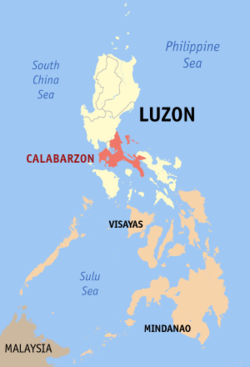CALABARZON
|
Calabarzon Southern Tagalog Mainland Region IV-A |
|||||
|---|---|---|---|---|---|
| Region | |||||
|
|||||
|
|||||
 Location in the Philippines |
|||||
| Coordinates: 14°00′N 121°30′E / 14°N 121.5°ECoordinates: 14°00′N 121°30′E / 14°N 121.5°E | |||||
| Country | Philippines | ||||
| Island group | Luzon | ||||
| Regional center | Calamba (Laguna) | ||||
| Area | |||||
| • Total | 16,873.31 km2 (6,514.82 sq mi) | ||||
| Population (2015 census) | |||||
| • Total | 14,414,774 | ||||
| • Density | 850/km2 (2,200/sq mi) | ||||
| Time zone | PST (UTC+8) | ||||
| ISO 3166 code | PH-40 | ||||
| Provinces | |||||
| Cities | |||||
| Municipalities | 124 | ||||
| Barangays | 4,011 | ||||
| Cong. districts | 19 | ||||
| Languages | |||||
Calabarzon (/ká-lɑ-bɑr-zon/), formally known as Southern Tagalog Mainland and designated as CALABARZON Region, is an administrative region in the Philippines. The region comprises five provinces, Cavite, Laguna, Batangas, Rizal, and Quezon, whose names form the acronym CALABARZON. Its regional center is Calamba in Laguna.
Situated just south of Metro Manila in southwestern Luzon, the region is the most populous in the Philippines, having 14,414,774 inhabitants in 2015, and is also the country's second most densely populated after NCR. Prior to its creation as a region, Calabarzon, together with Mimaropa, formed the historical region known as Southern Tagalog, until they were separated in 2002 by virtue of Executive Order No. 103.
The region is home to some of the most important Philippine historical figures, most notable of which is the Philippines' national hero, Jose Rizal, who was born in Calamba.
Historical events occurring in the Calabarzon region date back as early as the year 900 with the appearance of the Laguna Copperplate Inscription, which referenced the cancellation of a debt as enforced by the Lakan of the Kingdom of Tondo. Natives in Batangas have populated the Pansipit River and have engaged in trade with China during the 13th century. The Southern Tagalog region was populated by independent villages composed of 50 to 100 families called barangays.
...
Wikipedia




